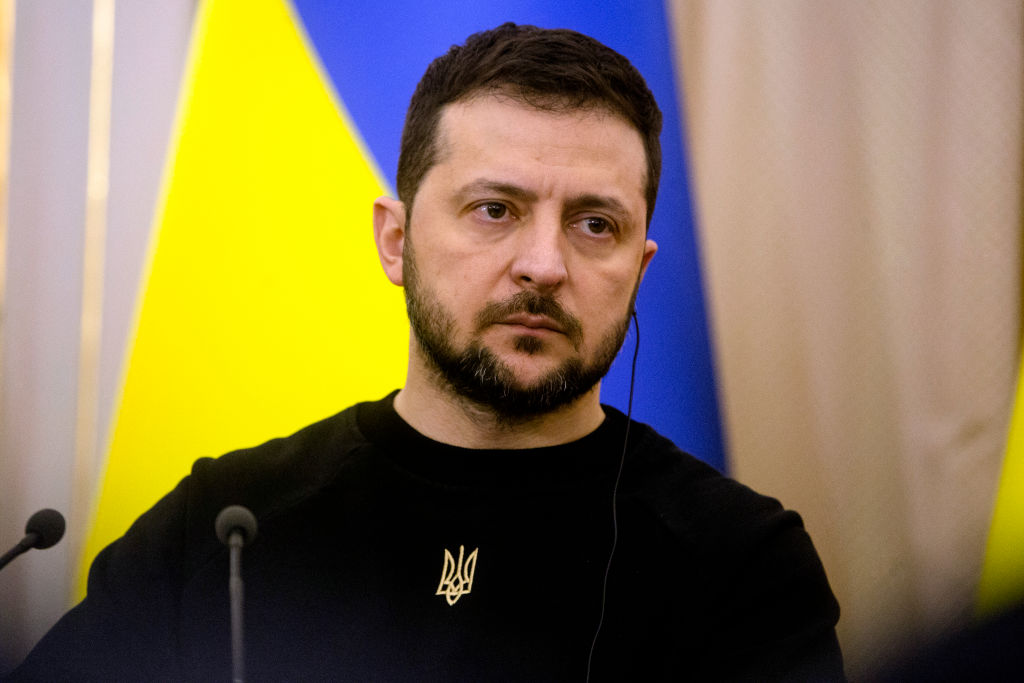While the West calculates whether each new arms shipment it sends to Ukraine risks escalating the conflict with Russia, Ukrainian officials are taking matters into their own hands.
The country has produced and successfully launched “new, Ukrainian weapons” with a range of more than 400 miles, President Volodymyr Zelensky said last week, one day after a drone attack on an air base in Pskov, Russia, some 400 miles from the Ukrainian border. (Ukraine’s military intelligence chief claimed the drones had been launched from Russian soil.)
And Oleksiy Danilov, secretary of Ukraine’s National Security and Defense Council, took rumors about the country’s long-range capabilities a step further, alleging that a Ukrainian-made missile had been behind the destruction of a Russian S-400 anti-aircraft missile system deployed near the occupied Ukrainian village of Olenivka last month.
“The missile was new. The missile was absolutely modern,” Danilov said. “Yes, this is our new product, which proved to be absolutely flawless.”
The embattled country has taken steps recently to revamp its once-robust arms industry—which was largely exhausted or destroyed in the early stages of Russia’s invasion—including through the reported development and manufacturing of long-range weapons. A vibrant defense sector, supplemented by NATO support, would go a long way both in bolstering Ukraine’s immediate defensive war effort and in deterring post-war Russian aggression.
Zelensky last month unveiled plans to make Ukraine into a leading force in the military technology sector, hailing his country’s extensive combat experience as an asset in the development of new weapons. “It is of great importance that we are a tester, a pioneer—in the good sense of the word—of the launch and use of many types of ammunition. Modern ones,” he said. “This is a great example for many businessmen around the world. I think we will be number one in this area—military tech and digital. At least on the European continent.”
Ukraine has recently begun manufacturing NATO-standard equipment, Zelensky added, including the highly in-demand 155mm artillery shell that’s used in howitzers and other weapons systems. But Ukrainian officials say there’s room for more co-production with Europe and the U.S. Ukraine’s state-owned weapons producer, Ukroboronprom, has been reaching out to Western defense companies in an effort to foster a network of defense industry cooperation—from the manufacturing level on up. The pitch is simple: Work with us to develop and produce systems for a modern conflict, gauge their performance on the battlefield, and market to future prospective buyers accordingly.
The argument has found at least one audience: German defense manufacturer Rheinmetall recently signaled its desire to work with Ukroboronprom to manufacture Fuchs armored vehicles. But other Western companies are hesitant to open facilities in Ukraine in light of the danger posed by Russian aerial attacks.
“Obviously there will be challenges. The Russians will try to hit those facilities, but there are a lot of underground facilities dating back to the Soviet era—bunkers and the like,” Dmitri Alperovitch, founder of the Silverado Policy Accelerator think tank, tells The Dispatch. “You could build caves into the mountains [in the West] that would be much more difficult for the Russians to hit. There are ways to cope with the missile threat.”
Plus, this is the only active theater of war in which arms manufacturers can see their products up against the kind of advanced weaponry Russia employs. “So it’s really the best way that Western firms can test their new capabilities and get real world feedback pretty close to real-time on how systems are performing to adjust them and make improvements,” Alperovitch says.
Aside from partnering with Western manufacturers, Ukraine is also hoping to expand the use of its own indigenous weapons systems—including those that it developed well before the invasion, like Skif and Corsar anti-tank guided missiles. Ukrainian-made drones, both aerial and maritime, have also been critical in Ukraine’s push against a superior conventional military. And efforts to scale up production of the R-360 Neptune—an anti-ship missile first deployed by Ukraine in 2021 and responsible for the sinking of the Moskva—will be key to countering the naval might of Russia’s Black Sea fleet.
Ukraine faces a steeper challenge with its long-range capabilities. While it remains unclear whether Kyiv has successfully developed and deployed long-range missiles of its own, the U.S. and Europe have a range of systems capable of striking targets from great distances.
France announced the delivery of long-range SCALP missiles to the Ukrainian military in July, and the United Kingdom has been sending Ukraine its own version of the weapon, the Storm Shadow, since May. Kyiv has also pushed for German-made Taurus missiles and American Army Tactical Missile Systems (ATACMS), but neither has reached the battlefield over apparent fear of escalation with Russia. Ukraine’s NATO supporters have repeatedly sought assurances from the country that it won’t use the weapons they supply to strike Russian soil.
“Ukraine strictly adheres to the obligation not to use the weapons of its partners to strike Russian territory,” Mykhailo Podolyak, adviser to the head of the Office of the President of Ukraine, said last week.
That leaves it up to Ukraine to strike Russian soil with indigenous weaponry—and it’s likely to do just that. The cross-border attacks do more than just boost morale in Ukraine and sow fear inside Russia. By demonstrating that they can hit Putin at home, the Ukrainians are signaling that any further Russian aggression can be met with more than just a defensive strike at the battlelines.
“If Ukraine wants to create deterrence against Russia, it’ll have to do that with its own weaponry,” Alperovitch says. “This can be a key component of the Ukrainian economy post-war. Much of the Ukrainian economy has been decimated because of the Russian bombings. If you’re looking forward, post-war, to where Ukraine can quickly gain market share and export markets, weapons systems is really one of the few areas where they can be very competitive quickly.”







Please note that we at The Dispatch hold ourselves, our work, and our commenters to a higher standard than other places on the internet. We welcome comments that foster genuine debate or discussion—including comments critical of us or our work—but responses that include ad hominem attacks on fellow Dispatch members or are intended to stoke fear and anger may be moderated.
With your membership, you only have the ability to comment on The Morning Dispatch articles. Consider upgrading to join the conversation everywhere.